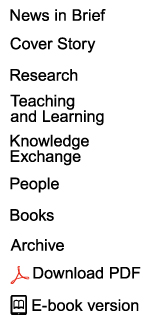Cover Story
Disaster has struck – the air conditioner has leaked overnight, thoroughly soaking your antique books collection that was kept on the shelf beneath. What do you do?
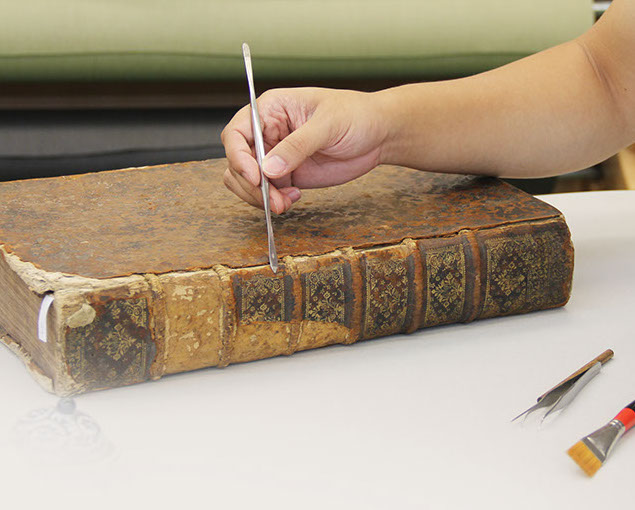
Consolidating leather on a book spine.

This was the premise of a workshop co-organised by the Preservation and Conservation Division (PCD), part of HKU’s Libraries and located in a sprawling workshop in Aberdeen. Head of the PCD Ms Jody Beenk and her 10-strong team of skilled conservators and binders work daily to repair, preserve and conserve books, scrolls, photos and documents.
The Division was formed in 2010, although the University has had a bindery since 1953. The conservators in the PCD – most of whom trained outside Hong Kong as there is little training available locally – have been running a series of workshops designed to pass on their specialist knowledge to the public and others involved in associated industries.
“The workshops are aimed both at people inside the industry looking to extend specific knowledge and also at the public – so students, curators, conservators, archivists and collections managers across the GLAM [Galleries, Libraries, Archives and Museums] sector,” said Ms Beenk. “They are not structured to create conservators – preservation is a discipline that requires extensive training – but rather to emphasise collections care, how to assess a collection, how best to preserve it and knowing when to hire outside experts.”
The series of Knowledge Exchange-funded workshops are run in collaboration with several partners across campus, including the University Museum and Art Gallery (UMAG), University Libraries (HKUL), Archives, and Architectural Conservation Programmes (ACP), as well as external organisations including the Getty Conservation Institute, AXA Art Asia and M+, the museum that will form the cornerstone of the West Kowloon Cultural District Project and which is due to open officially in 2018.
Subjects covered include: an introduction to the Getty’s ‘Arches’ heritage inventory system; handling and packing art and artifacts for transportation; caring for and identifying photographs (from daguerreotypes to digital); and an upcoming workshop in December will look at pest management.
Perhaps the most popular was the workshop about coping with emergencies, led by
Ms Priscilla Anderson, a senior preservation librarian from Harvard. It included how to respond to an emergency effectively to prevent damage to the most vulnerable collections, and how to salvage a variety of wet collection types during the recovery phase, “For this workshop we soaked several shelves of books, maps and audio formats overnight,” said Ms Beenk, “then basically said to participants, ‘We have an emergency, what do you do first?’ Since that workshop there have been no fewer than five such emergencies at HKU. Luckily HKUL staff attended the course, so they knew what to do!”
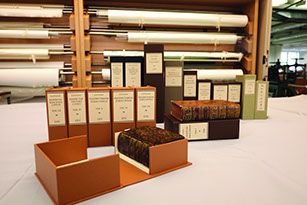
Rare book enclosures fabricated in the University Libraries Preservation Centre.
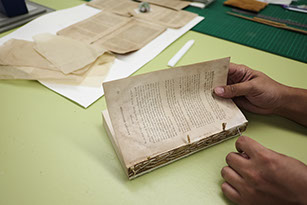
Sewing an 18th-century book.
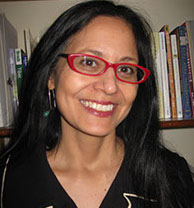
![]() The conservator’s skill is not only in having the practical knowledge and skills required to know how to repair or preserve an item. It’s also about having a sense of the social and cultural history of a piece.
The conservator’s skill is not only in having the practical knowledge and skills required to know how to repair or preserve an item. It’s also about having a sense of the social and cultural history of a piece. ![]()
Ms Jody Beenk
Standards and ethics
Interestingly, it was a water damage emergency – floods in Florence, Italy in 1966 – that marked what is considered the start of book preservation. “It led to the setting up of proper standards for the craft,” said Ms Beenk. “The introduction of uniform ways to treat damage and to document repairs, and the creation of standards and ethics.”
As an international university of stature, HKU needed a proper preservation centre,
Ms Beenk emphasised, adding that it is the only university in Hong Kong to have an established centre. “We also have an informal preservation group, whose members include UMAG’s Dr Florian Knothe and Mr Christopher Mattison, and Professor Lynne DiStefano and Ms Gesa Schwantes from ACP.
“Conservation is becoming more important in this part of the world,” said Ms Beenk. “The International Institute for Conservation of Historic and Artistic Works held its annual Congress in Hong Kong for the first time last year, and as a result of that is now working in collaboration with the Forbidden City in Beijing. Ms Beenk was recently invited to the Sun Yat-sen University in Guangzhou to speak about the workshops at the South China Preservation and Conservation Forum.
There is certainly more than enough work to keep the PCD team busy. Bookbinding takes up much of the time, with a steady stream of volumes being shuttled daily between the main campus libraries and the Division in Aberdeen. It can be as simple as replacing a torn hard-cover on a relatively modern book or as complicated as painstakingly reforming damaged pages using paper specially made to match as closely as possible the original.
They also sew pages back in, remove aged sellotape that’s been used for amateur repairs, restore pages that have been nibbled by cockroaches, and make digitised editions of works that are too delicate to be handled. While at one desk a member of staff is repairing page by page local newspapers dating from the 1960s, another is custom-making enclosures (protective boxes) for law tomes that are several hundred years old, and two more staff are gold-stamping titles on newly constructed book covers.
The PCD provides these services both for the University and for private clients. “We get enquiries from corporations who have a big anniversary, such as a centenary coming up,” said Ms Beenk. “People start looking at documents they have in storage and realise they have interesting items but they are delicate and need careful handling.”
Asked to sum up what the Division does, she said: “The conservator’s skill is not only in having the practical knowledge and skills required to know how to repair or preserve an item. It’s also about having a sense of the social and cultural history of a piece.”
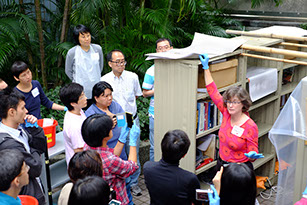
Workshop participants receive guidance before tackling wet books.
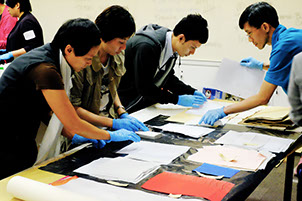
Workshop participants collaborate to sort wet documents.

